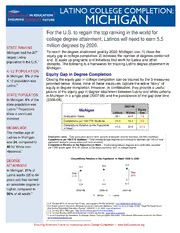
ERIC ED532113: Latino College Completion: Michigan PDF
Preview ERIC ED532113: Latino College Completion: Michigan
LATINO COLLEGE COMPLETION: MICHIGAN For the U.S. to regain the top ranking in the world for college degree attainment, Latinos will need to earn 5.5 million degrees by 2020. STATE RANKING Michigan had the 20th To reach the degree attainment goal by 2020, Michigan can: 1) close the equity gap in college completion; 2) increase the number of degrees conferred; largest Latino and, 3) scale up programs and initiatives that work for Latino and other population in the U.S.1 students. The following is a framework for tracking Latino degree attainment in Michigan. K-12 POPULATION Equity Gap in Degree Completion In Michigan, 5% of the Closing the equity gap in college completion can be tracked by the 3 measures K-12 population was provided below. Alone, none of these measures capture the entire “story” of Latino.2 e quity in degree completion. However, in combination, they provide a useful picture of the equity gap in degree attainment between Latino and white cohorts STATE POPULATION in Michigan in a single year (2007-08) and the persistence of the gap over time In Michigan, 4% of the (2006-08). state population was 2007-08 Latino.3 Projections Michigan Equity Latinos Whites Gap show a continued Graduation Rates 39.1 46.9 7.8 increase. Completions per 100 FTE Students 15.3 18.2 2.9 Completions Relative to the Population MEDIAN AGE in Need 14.5 38.8 24.3 The median age of Latinos in Michigan Graduation rates - Total graduation within 150% percent of program time for first-time, full-time freshman Completions per 100 FTE students – Total undergraduate degrees and certificates awarded per 100 full-time was 24, compared to equivalent students (incorporates part-time students) Completions Relative to the Population in Need – Total undergraduate degrees and certificates awarded 40 for White non- per 1,000 adults aged 18 to 44 relative to the adult population with no college degree Hispanics.4 Completions Relative to the Population in Need: 2006 to 2008 DEGREE ATTAINMENT 38.8 36.6 34.5 In Michigan, 21% of Gap: Gap: Latino adults (25 to 64 21.6 24.3 years old) had earned an associate degree or 12.9 13.4 14.5 higher, compared to 2005-06 2006-07 2007-08 36% of all adults.5 White Latino 1 U.S. Census 2010, American Fact Finder, Demographic Profile Summary. http://factfinder2.census.gov 2 U.S. Department of Education, National Center for Education Statistics, Common Core of Data (CCD), "State Nonfiscal Public Elementary/Secondary Education Survey", 2009-10, v.1b. www.nces.ed.gov/ccd 3 U.S. Census 2010: Michigan. http://2010.census.gov/2010census/data/ 4 U.S. Census Bureau, 2006-2010 American Community Survey. www.census.gov/acs 5 Lumina Foundation for Education. A Stronger Nation Through Higher Education. Educational Attainment Levels for the States. www.luminafoundation.org Ensuring America’s Future by Increasing Latino College Completion • www.EdExcelencia.org Degrees Conferred Another metric to benchmark college completion is to track the progress of total degrees awarded over time. This measure may be the result of an increase in overall enrollment numbers rather than an increase in rates of completion. From 2005-06 to 2007-08, • the number of Hispanics who earned an undergraduate degree in Michigan increased about 7% from 2006-08, while all other race/ethnic groups increased 3%. • among the 50 states, Michigan ranked 26th for the increase in degrees conferred to Latinos over 3 years. For more information on these metrics, download Benchmarking Latino College Completion to Meet National Goals: 2010 to 2020 and Degrees Conferred to Latinos: 2006-2008 at www.EdExcelencia.org/research/EAF/Benchmarking Examples of What Works for Latino Students There are institutions in Michigan showing success in enrolling, retaining, and graduating Latino students. The following is an example of an institutional program with evidence of effectiveness in serving Latino students nominated for Examples of Excelencia. Center for Chicano-Boricua Studies – Wayne State University The mission of the Center for Chicano-Boricua Studies (CBS) is to transform the University, and ultimately society, by providing equitable access to a quality university education to students interested in U.S. Latina/o and Latin American cultural studies while enhancing diversity on campus. Now celebrating its 40th Anniversary, CBS accomplishes its mission through an integrated four-part program including: 1) Comprehensive Student Services and Academic Success Programs, 2) Research on U.S. Latina/o and Latin American Culture, 3) Internal University Advocacy on Latina/o Issues, and 4) Outreach and Service to Broader Communities. CBS participants largely outperform their WSU First Time in Any College (FTIAC) peers in all areas of measured student success. CBS participants passed English 1010 at a rate of 94% during their first fall semester, passed Math 0993 at a rate of 80% during the same semester, were retained at a rate of 86% and persisted into the following semester at a rate of 91%. This is compared to WSU success rates of 71% in English 1010, 44% in Math 0993, an 89% retention rate and a 75% fall-to-fall persistence rate for 2008 FTIACs. Despite enrolling students with lower average high school grade point averages and ACT scores, CBS Scholars generally outperform their WSU FTIAC peers. (http://www.clas.wayne.edu/cllas/) For more information on institutional programs improving Latino student success in higher education, access Excelencia in Education’s Growing What Works database at http://www.edexcelencia.org/examples Ensuring America’s Future partners in Michigan: Corporation for a Skilled Workforce: www.skilledwork.org Kresge Foundation: www.kresge.org Midwestern Higher Education Compact (MHEC): www.mhec.org Ensuring America’s Future by Increasing Latino College Completion • www.EdExcelencia.org
